The idea for a technical school was put forward in 1886, but there was little enthusiasm for the idea then. It resurfaced a year later as an idea to celebrate Queen Victoria's Golden Jubilee. The foundation stone was laid on the 9th of May 1888 by the Prince and Princess of Wales. The building opened for students in September 1889. It had three floors and a basement, with sheds at the back for students of textiles. The site on Feilden Street is now part of Blackburn College.
A weekly exchange meeting was held in the Old Bull Inn. A proposal to build an exchange on the site of the market cross failed and the weekly meeting moved to the vestibule of the Town Hall.
The corner stone for the Exchange was laid on March 10th 1863 and it opened in 1865. The architecture is 14th century gothic. The building comprised a large hall with ante-rooms, a two storey tower with hall, assembly room and newsroom.
The Exchange later became a lecture and concert hall and later still a cinema, being known successively as the Exchange Hall, the Majestic, the Essoldi and the Classic.
The church of St. Mary and St. John the Baptist was built between 1816 and 1819. It was built by John Francis Butler as a thanksgiving for his recovery from an accident.
John Palmer of Manchester was the architect of this 'astonishing church' to use Pevsner's words. A number of architectural styles and conventions contribute to the overall effect. It is a Grade 1 listed building, one of only two in the Borough, the other being Turton Tower.
The site now occupied by the Public Halls was a notorious slum. It was cleared so George V could lay the foundation stone on July 10th 1913. The first World War delayed work and the halls were not opened until 21st October 1921.
There were three halls, two with sprung floors for dancing and one with a cinema screen. The halls were designed to be used separately, but could be linked if all were required for a function.
King George's Hall is a listed building.
In January 1907 a new plan for Blakey Moor was published by architects Briggs and Wolstenholme and Stones and Stones. Blakey Moor had been in ancient times unenclosed common land, used for fairs. In 1617 a Royal Commission divided the land up between the town's big land owners. In 1821 the cattle market was removed there from Darwen Street. The Moor was the scene of many public assemblies; the Chartists held demonstrations there. In the 1830s conflict between the rights of the Fieldens who owned the Moor and the requirements of the developing town led to a court case at Lancaster Assizes.

By 1888 part of the Moor had been cleared and the foundation of the Technical School was laid. Clearance of what had become the most dilapidated and disreputable area of the town continued and various plans were put forward for the best use of the site. The 1907 plans envisaged the incorporation of a new fire station in the scheme. The town's fire engine had formerly been kept at Engine Street at the top of Blakey Moor. In the event the plans were modified and it was decided to drop the fire station scheme. Instead the architects were instructed to provide plans for a new school.

Blakey Moor Higher Elementary School opened in July 1911. The site incorporated a new swimming pool. 392 boys and girls were accommodated on the upper floor and 421 under the age of 12 on the lower floor. The Sessions House opened in 1912 and on July 10th 1913 King George V lay the foundation stone for the public halls. The First World War disrupted work, and it wasn't until October 21st 1921 that Lord Derby declared the public halls open
Built in 1788, originally intended as a chapel of ease for St Mary's. The tower added in 1802 is the most striking feature, having a square base, a higher portion with chamfered edges and then an octagonal upper portion. The church's architect is unknown.
The information below was provided by Stuart Parker of St. George's Church Council.
The Church opened its doors on St. George's Day 1907. The Church was established by Rev. Henry Sobey who was originally a Lay Reader at nearby St. Francis Church. His services were dispensed of by the Vicar Rev. Woodall in favour of a Curate. There were a number of reports on the dispute at the time in the Blackburn Times.
The Church was very much a church of the common man. The founders of the Church who signed the original mortgage deeds included 4 weavers and 2 spinners.
Land was purchased on Archibald Street, Mill Hill. The original structure was of corrugated iron with brick foundations and provision for 300 people (they must have been very small people as I cannot imagine fitting in 300
people today !)
During the First World War, 28 men from the congegation were lost in battle. A pulpit was installed in the Church as a war memorial, along with a plaque dedicated to those who gave their lives. In additon, there is another plaque with the names of all those from the Church who went to war.
The Church was very popular and boasted very good support to help pay off the mortgage. The Church was extended and improved in the early 1920's whilst Rev. Sobey was still minister.
After 34 years service at St. George's, Rev Sobey passed away in 1941.
The Church continued under the stewardship of a number of different ministers over the following years.In the 1950's the Church was noted for its Scout and Guide groups, which met in the former Salvation Army hut on Angela Street which was purchased by the Church.
The Church also had a very well attended youth club and cricket and football teams.
Two of the town's former Mayors are linked with the Church. Councillor John Williams was a former member of the youth club and a Scouter at the Church.
Councillor Maureen Bateson was a former Rose Queen at the Church and her father Harry Hodkinson was a Church Warden for many years.

Today, the Church is under the Stewardship of Rev William Hall. Rev Hall was brought up in Mill Hill and has been a member of the Church all his life.
He has had numerous roles over the years, from Cub Master, minutes secretary to the Church Council, Lay Reader and then following his retirement as a science teacher in Blackpool, he become full time minister of the Church. He has given dedicated service to the work of the Church for almost 60 years. He was lay reader at the 50th anniversary of the Church !
The Church is used as both a place of worship and as a meeting place for Scout and Guide Groups. Over recent months a major refurbishment of the Church has been underway to ensure the building is in good repair and is
a beautiful place to worship, for the journey through it's next 100 years.
The 'Centenary Stone' was unveiled by Bishop Kenneth Powell, Bishop Primus of the Free Church of England on Sunday 22nd April.
Further information about St. George's can be found on their website.
In 1903 the Tower was acquired by yet another scion of local stock - a member of the Knowles family who, through enterprise in the Lancashire Coalfield, national politics and public service, was able to boast of a baronetcy.
Once again the local hunt would gather at the Tower. But like so many of the previous owners of Turton Tower, Sir Lees Knowles owned another home elsewhere and when he died his widow, Nina, chose to live at her other house in Pendlebury.
In 1930 she presented the Tower to the Local Authority, the Turton Urban District Council. The Drawing Room became the new Council Chamber. The Dining Room served as a Committee Room. George Ashworth, a local resident, worked hard to convert part of the building into a Museum. Colonel Hardcastle of nearby Bradshaw Hall, when that building was demolished, presented a large part of his own collection of antiques to the Tower.
In 1930 she presented the Tower to the Local Authority, the Turton Urban District Council. The Drawing Room became the new Council Chamber. The Dining Room served as a Committee Room. George Ashworth, a local resident, worked hard to convert part of the building into a Museum. Colonel Hardcastle of nearby Bradshaw Hall, when that building was demolished, presented a large part of his own collection of antiques to the Tower.
When Local Government Reorganisation in 1974 cut the eighty year old Turton Urban District in half, Bradshaw, Bromley Crossand neighbouring areas joined Bolton while Edgworth, Belmont and Chapeltown, including the Tower, were joined to Blackburn.
The Barn on Dove Hill is today privately owned, as is the old Summer-House nearby. But eight acres of land which surround the Tower are open to the public as a park and the footpath across the railway line can lead for a walk across the moors, and to the site of the neolithic stone circles up on Chetham's Close.
Chapeltown railway station, which used to serve the village and the Tower, has been closed and converted into a woodyard. But by following the footpath from the Tower to the station you will meet the other path that leads from the station to the village.
Today the quickest way to reach the Tower, by public transport from Blackburn or Manchester, is to travel by train to Bromley Cross and then catch the bus which brings you to the Tower.

